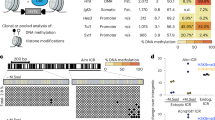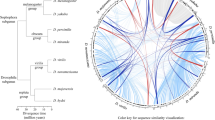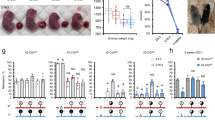Abstract
Genomic imprinting as originally described in Sciara1 is displayed by many organisms. In mammals, X-inactivation and the parent-of-origin-specific silencing of imprinted genes are examples of this phenomenon2,3. A heritable chromatin structural modification may be the critical mechanism in such instances of chromosome condensation and preferential gene inactivation. H19 is an imprinted gene4 in which the repressed paternal allele is hypermethylated and the compacted chromatin is relatively resistant to digestion by nucleases5–7. In order to uncover underlying conserved epigenetic mechanisms we have introduced a mouse H19 transgene into Drosophila. We show here that a 1.2-kb H19 upstream sequence functions in cis as a parent-of-origin independent silencing element in Drosophila. Strikingly, this cis-acting element is located within an upstream region that is necessary for H19 imprinting in mice8. These results suggest involvement of an evolutionary conserved mechanism in both gene silencing in Drosophila and imprinting in mice.
This is a preview of subscription content, access via your institution
Access options
Subscribe to this journal
Receive 12 print issues and online access
$209.00 per year
only $17.42 per issue
Buy this article
- Purchase on Springer Link
- Instant access to full article PDF
Prices may be subject to local taxes which are calculated during checkout
Similar content being viewed by others
References
Crouse, H.V. The controlling element in sex chromosome behaviour in Sciara. Genetics 45, 1429–1443 (1960).
Efstratiadis, A. Parental imprinting of autosomal mammalian genes. Curr. Opin. Genet. Dev. 4, 265–280 (1994).
John, R.M. & Surani, M.A. Imprinted genes and regulation of gene expression by epigenetic inheritance. Curr. Opin. Cell Biol. 8, 348–353 (1996).
Bartolomei, M.S., Zemel, S. & Tilghman, S.M. Parental imprinting of the mouse H19 gene. Nature 351, 153–155 (1991).
Bartolomei, M.S., Webber, A.L., Brunkow, M.E. & Tilghman, S.M. Epigenetic mechanisms underlying the imprinting of the mouse H19 gene. Genes Dev. 7, 1663–1673 (1993).
Ferguson-Smith, A.C., Sasaki, H., Cattanach, B.M. & Surani, M.A. Parental-origin-specific epigenetic modification of the mouse H19 gene. Nature 362, 751–755 (1993).
Li, E., Beard, C. & Jaenisch, R. Role for DNA methylation in genomic imprinting. Nature 366, 362–365 (1993).
Elson, D.A. & Bartolomei, M.S. A 5′ differentially methylated sequence and the 3′ flanking region are necessary for HI9 transgene imprinting. Mol. Cell. Biol. 17, 309–317 (1997).
Leighton, P.A., Ingram, R.S., Eggenschwiler, J., Efstratiadis, A. & Tilghman, S.M. Disruption of imprinting caused by deletion of the H19 gene region in mice. Nature 375, 34–39 (1995).
Urieli-Shoval, S., Gruenbaum, Y., Sedat, J. & Razin, A. The absence of detectable methylated bases in Drosophila melanogaster DNA. FEBS Lett. 146, 148–152 (1982).
Patel, C.V. & Gopinathan, K.P. Determination of trace amounts of 5-methylcytosine in DNA by reverse-phase high-performance liquid chromatography. Anal. Biochem. 164, 164–169 (1987).
Yoo-Warren, H., Pachnis, V., Ingram, R.S. & Tilghman, S.M. Two regulatory domains flank the mouse tf H19 gene. Mol. Cell. Biol. 8, 4707–4715 (1988).
Robertson, H.M. et al. A stable genomic source of P element transposase in Drosophila melanogaster. Genetics 118, 461–470 (1988).
Daniels, S.B., McCarron, M., Love, C. & Chovnick, A. Dysgenesis-induced instability of rosy locus transformation in Drosophila melanogaster. analysis of excision events and the selective recovery of control element deletions. Genetics 109, 95–117 (1985).
Tremblay, K.D., Saam, J.R., Ingram, R.S., Tilghman, S.M. & Bartolomei, M.S. A paternal-specific methylation imprint marks the alleles of the mouse H19 gene. Nature Genet. 9, 407–413 (1995).
Zink, D. & Paro, R. Drosophila Polycomb-group regulated chromatin inhibits the accessibility of a trans-activator to its target DNA. EMBO J. 14, 5660–5671 (1995).
Pirrotta, V. in Vectors: A survey of molecular cloning vectors and their uses (eds Rodriguez, R.L. & Denhardt, D.T.) 437–456 (Butterworths, Boston, 1988).
Messmer, S., Franke, A. & Paro, R. Analysis of the functional role of the Polycomb chromo domain in Drosophila. Genes Dev. 6, 1241–1254 (1992).
Spradling, A.L. & Rubin, G.M. Transformation of cloned P elements into Drosophila germ line chromosomes. Science 218, 341–347 (1982).
Sambrook, J., Fritsch, E.F. & Maniatis, T. Molecular cloning: A Laboratory Manual (Cold Spring Harbor Laboratory Press, New York, 1989).
Reuter, G. & Wolff, I. Isolation of dominant suppressor mutations for position-effect variegation in Drosophila melanogaster. Mol. Gen. Genet. 182, 516–519 (1981).
Author information
Authors and Affiliations
Rights and permissions
About this article
Cite this article
Lyko, F., Brenton, J., Surani, M. et al. An imprinting element from the mouse H19 locus functions as a silencer in Drosophila. Nat Genet 16, 171–173 (1997). https://doi.org/10.1038/ng0697-171
Received:
Accepted:
Issue Date:
DOI: https://doi.org/10.1038/ng0697-171
This article is cited by
-
Mammalian viviparity: a complex niche in the evolution of genomic imprinting
Heredity (2014)
-
The maize b1 paramutation control region causes epigenetic silencing in Drosophila melanogaster
Molecular Genetics and Genomics (2012)
-
The Drosophila homolog of the mammalian imprint regulator, CTCF, maintains the maternal genomic imprint in Drosophila melanogaster
BMC Biology (2010)
-
Genomic Imprinting in Drosophila has properties of both mammalian and insect imprinting
Development Genes and Evolution (2009)
-
Non‐coding transcripts in the H19 imprinting control region mediate gene silencing in transgenic Drosophila
EMBO reports (2007)



